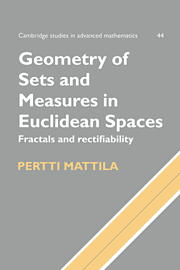Book contents
- Frontmatter
- Contents
- Acknowledgements
- Basic notation
- Introduction
- 1 General measure theory
- 2 Covering and differentiation
- 3 Invariant measures
- 4 Hausdorff measures and dimension
- 5 Other measures and dimensions
- 6 Density theorems for Hausdorff and packing measures
- 7 Lipschitz maps
- 8 Energies, capacities and subsets of finite measure
- 9 Orthogonal projections
- 10 Intersections with planes
- 11 Local structure of s-dimensional sets and measures
- 12 The Fourier transform and its applications
- 13 Intersections of general sets
- 14 Tangent measures and densities
- 15 Rectifiable sets and approximate tangent planes
- 16 Rectifiability, weak linear approximation and tangent measures
- 17 Rectifiability and densities
- 18 Rectifiability and orthogonal projections
- 19 Rectifiability and analytic capacity in the complex plane
- 20 Rectifiability and singular integrals
- References
- List of notation
- Index of terminology
19 - Rectifiability and analytic capacity in the complex plane
Published online by Cambridge University Press: 05 August 2012
- Frontmatter
- Contents
- Acknowledgements
- Basic notation
- Introduction
- 1 General measure theory
- 2 Covering and differentiation
- 3 Invariant measures
- 4 Hausdorff measures and dimension
- 5 Other measures and dimensions
- 6 Density theorems for Hausdorff and packing measures
- 7 Lipschitz maps
- 8 Energies, capacities and subsets of finite measure
- 9 Orthogonal projections
- 10 Intersections with planes
- 11 Local structure of s-dimensional sets and measures
- 12 The Fourier transform and its applications
- 13 Intersections of general sets
- 14 Tangent measures and densities
- 15 Rectifiable sets and approximate tangent planes
- 16 Rectifiability, weak linear approximation and tangent measures
- 17 Rectifiability and densities
- 18 Rectifiability and orthogonal projections
- 19 Rectifiability and analytic capacity in the complex plane
- 20 Rectifiability and singular integrals
- References
- List of notation
- Index of terminology
Summary
Analytic capacity and removable sets
In this chapter we shall discuss a classical problem in complex analysis and its relations to the rectifiability of sets in the complex plane C. The problem is the following: which compact sets E ⊃ C are removable for bounded analytic functions in the following sense?
(19.1) If U is an open set in C containing E and f: U\E → C is a bounded analytic function, then f has an analytic extension to U.
This problem has been studied for almost a century, but a geometric characterization of such removable sets is still lacking. We shall prove some partial results and discuss some other results and conjectures. For many different function classes a complete solution has been given in terms of Hausdorff measures or capacities. For example, if the boundedness is replaced by the Holder continuity with exponent α, 0 < α < 1, then the necessary and sufficient condition for the removability of E is that H1+α(E) = 0, see Exercise 4, Dolzenko [1] and Uy [2], and for the corresponding question for harmonic functions Carleson [1]. Král [1] proved that for the analytic BMO functions the removable sets E are characterized by the condition H1(E) = 0. The problem (19.1) is more delicate, because the metric size is not the only thing that matters; the rectifiability structure also seems to be essential as we shall see.
Ahlfors [1] introduced a set function γ, called analytic capacity, whose null-sets are exactly the removable sets of (19.1).
- Type
- Chapter
- Information
- Geometry of Sets and Measures in Euclidean SpacesFractals and Rectifiability, pp. 265 - 280Publisher: Cambridge University PressPrint publication year: 1995



